Reviewed By DAN ORI

Dan has over 27 years’ under his belt caring for plants and gardens. Working as a Horticultural Instructor and Consultant, he draws on a diverse range of experience that includes working as a Head Gardener, Tree Surgeon, Garden Centre Trouble Shooter, and writer of academic papers. Dan has a Level 3 Diploma in Horticulture and is currently a candidate for the RHS’s most prestigious award – The Master of Horticulture.
IN THIS GUIDE
- 1) Viola odorata
- 2) Viola cornuta
- 3) Lavandula angustifolia
- 4) Aquilegia vulgaris
- 5) Aquilegia ‘Purple Emperor’
- 6) Verbena bonariensis
- 7) Streptocarpus
- 8) Perovskia atriplicifolia
- 9) Salvia verticillata
- 10) Salvia nemorosa
- 11) Leucophyllum frutescens
- 12) Phlox paniculata
- 13) Phlox subulata ‘Purple Beauty’
- 14) Vinca major
- 15) Vinca minor
- 16) Crocus sativus
- 17) Crocus vernus
- 18) Calluna vulgaris
- 19) Erica cinerea
- 20) Geranium × magnificum
- 21) Geranium himalayense
- 22) Agastache foeniculum
- 23) Pericallis × hybrida
- 24) Lupinus albifrons
- 25) Lupinus ‘Purple Emperor’
- 26) Iris germanica
- 27) Iris sibirica
- 28) Iris ‘Purple Magic’
- 29) Buddleja davidii
- 30) Clerodendrum myricoides ‘Ugandense’
- 31) Clematis viticella
- 32) Dianthus caryophyllus
- 33) Rhododendron ponticum
- 34) Rhododendron kaempferi
- 35) Oxalis triangularis
- 36) Trifolium pratense
- 37) Trifolium rubens
- 38) Hydrangea macrophylla
- References
If you’re looking for a perennial that produces stunning purple flowers that will return every year, then this is the list for you.
Here are thirty-eight of my favourite purple-flowering perennials that all have fantastic flowers of striking hues, ranging from pale lilac through rich purple to blackish violet.
1) Viola odorata

- COMMON NAME(S): sweet violet
- HARDINESS RATING: H6
- FOLIAGE: evergreen
- FLOWERING SEASON(S): winter / spring
- SUNLIGHT: full sun / part shade
I’ve begun this list with a classic purple flower that is even named after a shade of purple – the violet.
Incorrectly thought of solely as annuals, sweet violet is a hardy perennial that is one of two perennial varieties in the plant’s species.
Of course, there are innumerable cultivars in all shades of purple, but they are not reliable perennials.
Sweet Violet flowers often show ‘rabbit ears’.
“Viola odorata can be invasive or at best difficult to restrict as it spreads in a rhizomatous way (a mat of rhizome roots),” shares Master Horticulturist Dan Ori.
“For this reason, it may not be suitable for some borders.”
2) Viola cornuta

- COMMON NAME(S): horned pansy
- HARDINESS RATING: H5
- FOLIAGE: evergreen
- FLOWERING SEASON(S): spring / summer
- SUNLIGHT: full sun / part shade
Much like sweet violet, Pyrenean violets are low-growing mat-forming evergreens with brilliant green foliage.
They are only 2-3cm wide but are produced in profusion all through spring.
Violets are found in various shades of purple, from mauve through bright purple to deep violet.
3) Lavandula angustifolia

- COMMON NAME(S): English lavender
- HARDINESS RATING: H5
- FOLIAGE: evergreen
- FLOWERING SEASON(S): summer
- SUNLIGHT: full sun
Next up is the quintessential English purple flower, the English lavender.
This evergreen shrub of a bushy habit appears as a clump of upright plants when in flower, courtesy of those erect floral spikes that grow from 0.2-1m depending on the cultivar.
Each spike holds numerous tiny flowers of a royal purple hue which are renowned for their fragrance.
English Lavenders flower during summer.
4) Aquilegia vulgaris

- COMMON NAME(S): common columbine
- HARDINESS RATING: H7
- FOLIAGE: deciduous
- FLOWERING SEASON(S): spring / summer
- SUNLIGHT: full sun / part shade
With nearly 100 purple or purplish varieties to choose from, aquilegias are one of the list leaders of the purple perennials club.
Popularly known as columbines, these are herbaceous deciduous perennials.
For the most part, the flowers are delightfully charming, their intricate complexity only adding to their charms.
This common columbine variety is fully hardy and flowers throughout spring and well into the depths of the summer months.
5) Aquilegia ‘Purple Emperor’

- COMMON NAME(S): columbine ‘purple emperor’
- HARDINESS RATING: H5
- FOLIAGE: deciduous
- FLOWERING SEASON(S): spring / summer
- SUNLIGHT: full sun / part shade
Another columbine, ‘Purple Emperor’ has inner petals of a lighter shade framed by outer sepals in a darker one.
Columbines are among the few perennials that include flowers in deep, intense tones of violet, including an absolutely riveting black violet.
This variety pictured above has darker flowers than that of the common columbine listed above.
6) Verbena bonariensis

- COMMON NAME(S): purple top / Argentinian vervain
- HARDINESS RATING: H4
- FOLIAGE: deciduous
- FLOWERING SEASON(S): summer
- SUNLIGHT: full sun
By the standards of Botanical classification, quite a variety of perennials, both deciduous and semi-evergreen, fall under the umbrella of Verbena.
Though the little flowers vary in size, verbenas are all borne in big, handsome clusters and are displayed over a very long blooming season that often begins before summer and lasts until autumn.
As for the tone of purple, with Verbena you get to choose your shade from pale lavender right through to deep purple.
Argentinian vervain is of a pinky-purple shade and can reach up to 2.5m in height and spread.
“This is a beautiful plant that is great for pollinators, but be warned, as it can spread through your garden quickly,” says Dan.
“You and your neighbours may find yourselves constantly weeding Verbena bonariensis out of the random places it pops up.”
7) Streptocarpus
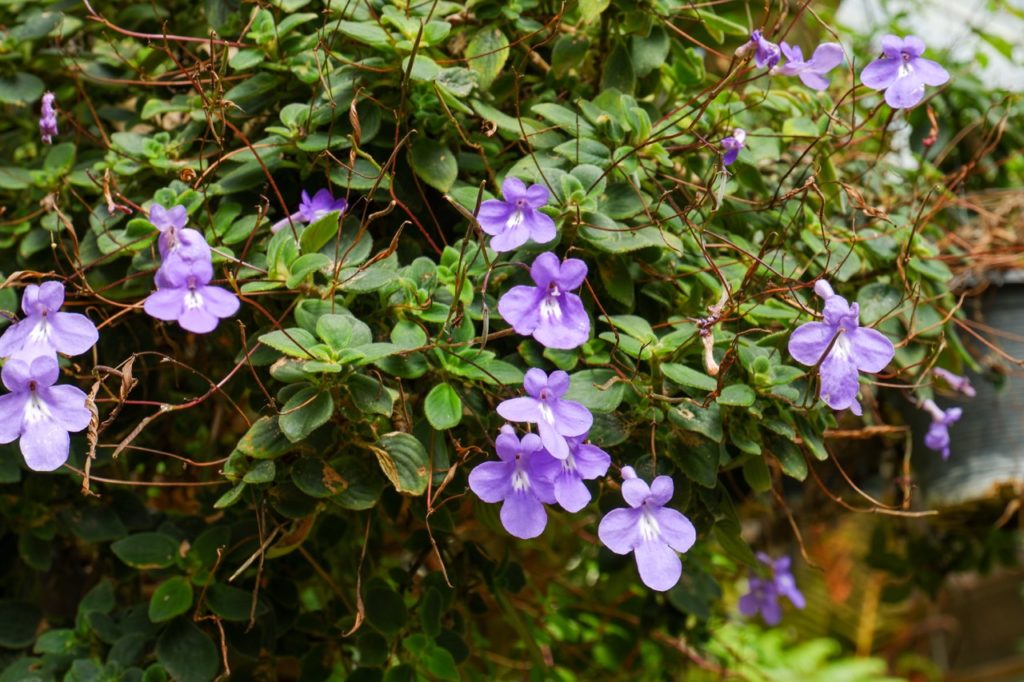
- COMMON NAME(S): cape primrose
- HARDINESS RATING: H1C
- FOLIAGE: evergreen
- FLOWERING SEASON(S): spring / summer / autumn
- SUNLIGHT: part shade
If you like to mix and match your colours, cape primrose might just be the purple plant for you, as many of its varieties come in bi-coloured shades.
With a hardiness rating of H1C, these plants are best grown indoors as houseplants here in the UK.
Despite this, the vast majority of Streptocarpus varieties are a mere 10-50cm high and wide and produce an abundance of ravishing flowers.
8) Perovskia atriplicifolia

- COMMON NAME(S): Russian sage
- HARDINESS RATING: H5
- FOLIAGE: deciduous
- FLOWERING SEASON(S): summer / autumn
- SUNLIGHT: full sun
A dizzying array of over 100 salvia cultivars come in purple hues, so it’s no surprise that Russian sage is the first of 3 of my favourites on this list.
This deciduous sage is one of the taller varieties and has two-toned purple flowers that make this perennial a particular favourite of mine.
9) Salvia verticillata

- COMMON NAME(S): whorled clary
- HARDINESS RATING: H5
- FOLIAGE: deciduous
- FLOWERING SEASON(S): summer
- SUNLIGHT: full sun
Of an upright habit, Salvia verticillata ranges from 0.5-1m in height with a narrow spread.
They bear small purple flowers ranging up and down spikes or in racemes, with this variety producing frillier flowers than others in its family.
10) Salvia nemorosa

- COMMON NAME(S): woodland sage
- HARDINESS RATING: H6
- FOLIAGE: evergreen
- FLOWERING SEASON(S): winter / spring
- SUNLIGHT: full sun / part shade
The last salvia on this list, woodland sage bears flowers that are fragrant and pull in squadrons of bees and butterflies.
Planted in drifts or beds, this plant makes a stunning sight in winter and spring, which is unusual for sage plants, which normally flower throughout the summer months.
11) Leucophyllum frutescens

- COMMON NAME(S): purple sage / Texas ranger / silverleaf
- HARDINESS RATING: H2
- FOLIAGE: evergreen
- FLOWERING SEASON(S): spring / summer
- SUNLIGHT: full sun
This evergreen easily grows to 1.5m in height with a similar spread, yet it is content in a large container.
Its small leaves are a dull silvery greyish-green and it produces plump blooms in regular flushes, sometimes with the rains and sometimes at its own sweet will.
The flowers are somewhat funnel-shaped in a vibrant shade of purple with a paler, stripy, speckled throat.
When in flower, Silverleaf is a favourite of the honeybees.
“Unfortunately, you are unlikely to find this plant available for sale in the UK as it requires a dry climate,” Dan shares.
12) Phlox paniculata
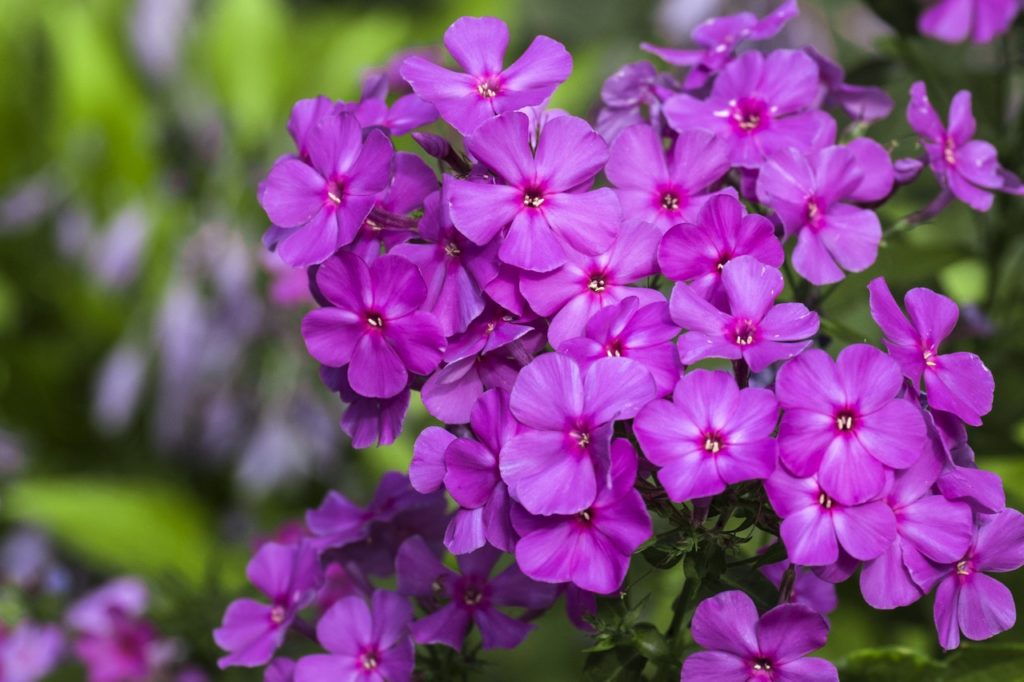
- COMMON NAME(S): perennial phlox
- HARDINESS RATING: H7
- FOLIAGE: deciduous
- FLOWERING SEASON(S): summer / autumn
- SUNLIGHT: full sun / part shade
Phlox is the answer for those who like bright purple hues.
These deciduous perennials are found in quite a span of heights up to 1.5m, though even the taller ones have a narrow spread as these plants are mostly of upright habit.
The perennial phlox produce lovely leaves that are oblong or lanceolate and of a soft, bright green hue.
13) Phlox subulata ‘Purple Beauty’

- COMMON NAME(S): moss phlox ‘purple beauty’
- HARDINESS RATING: H6
- FOLIAGE: evergreen
- FLOWERING SEASON(S): spring / summer
- SUNLIGHT: full sun / part shade
Although most cultivars are bright magenta-purple, the pale lilac blooms from this moss phlox variety are truly charming.
The flowers are wide-open and disk-shaped, with overlapping petals and are borne in clusters for most of the summer, which is also when their fragrance wafts through the air and draws in honeybees.
14) Vinca major

- COMMON NAME(S): greater periwinkle
- HARDINESS RATING: H6
- FOLIAGE: evergreen
- FLOWERING SEASON(S): spring / summer / autumn
- SUNLIGHT: full shade / full sun / part shade
Whether the Vinca species are major or minor, one thing is constant – the colour purple.
V. major is a slightly bigger plant at 40-50cm and bears somewhat bigger flowers at 5cm wide.
These five-petalled, wide-open, simple little flowers are charming in their own right.
This plant is considered invasive in many areas so be prepared to curtail its growth if you do plan on growing it at home.1Invasive to Avoid: Big Periwinkle. (n.d.). Wildlife. Retrieved March 23, 2023, from https://wildlife.ca.gov/Conservation/Plants/Dont-Plant-Me/Big-Periwinkle
15) Vinca minor

- COMMON NAME(S): lesser periwinkle
- HARDINESS RATING: H6
- FOLIAGE: evergreen
- FLOWERING SEASON(S): spring / summer
- SUNLIGHT: full shade / full sun / part shade
Vinca minor plants grow to between 10-30cm tall but can spread up to 3 times as wide.
What adds to their innocent charm is that they start blooming in spring and obligingly continue until the end of summer.
Most cultivars’ blooms are in soothing shades of purple and violet.
These easy-to-care-for evergreens are not specimen plants but are ideal for edging, bedding and cottage gardens.
16) Crocus sativus

- COMMON NAME(S): saffron crocus
- HARDINESS RATING: H6
- FOLIAGE: deciduous
- FLOWERING SEASON(S): autumn
- SUNLIGHT: full sun
Amongst all the spring flowering bulbs, the crocus is probably the one most would associate with the colour purple.
Even the white variety ‘Picturatus’ displays veins that, though finely etched, are in rich purple.
However, did you know that some crocuses can also flower in autumn?
C. sativus is one of these bulbs, and its pale purple flowers can add a touch of colour to the browning foliage as the months turn colder.
17) Crocus vernus
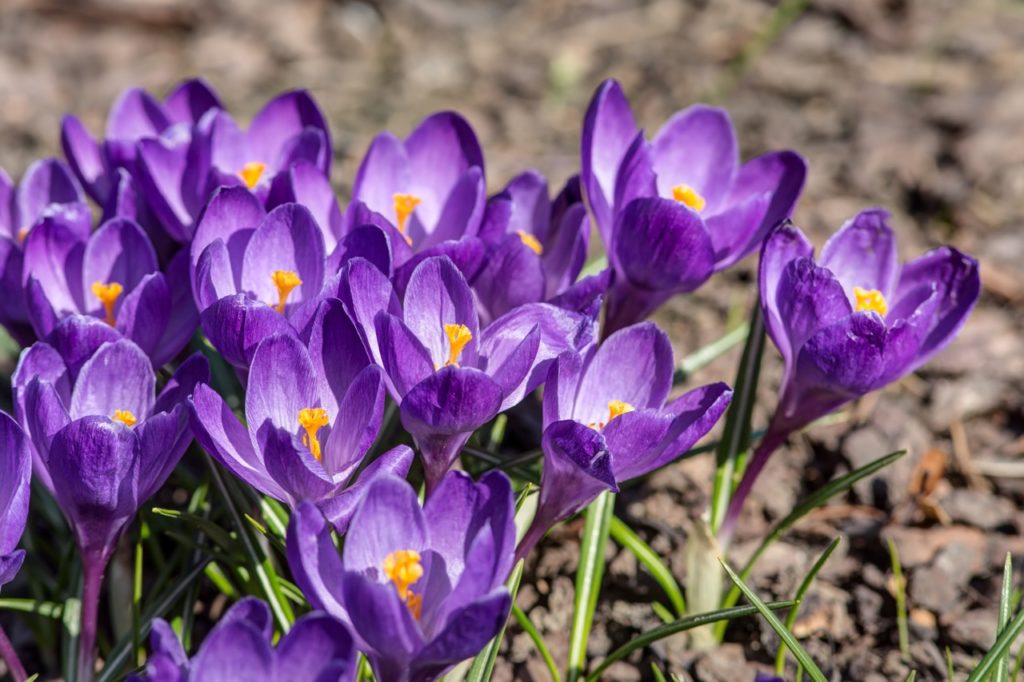
- COMMON NAME(S): spring crocus
- HARDINESS RATING: H6
- FOLIAGE: deciduous
- FLOWERING SEASON(S): spring / summer
- SUNLIGHT: full sun
The more popular spring-flowering crocuses have several cultivars that are bi-coloured or striped with purple, as well as the standard deep purple flowers.
This colour is wonderfully complemented by the bright yellow centres.
The goblet-shaped and stiffly upright and can bloom from early spring right through until the start of summer.
18) Calluna vulgaris

- COMMON NAME(S): heather
- HARDINESS RATING: H7
- FOLIAGE: evergreen
- FLOWERING SEASON(S): summer / autumn
- SUNLIGHT: full sun
Calluna and Erica varieties of heather have such different blooming seasons that if you combine the varieties correctly, you can enjoy their purple flowers all throughout the year.
Calluna vulgaris produces lovely flowers throughout summer and autumn that adorn the upright stems they grow along, so much so that they render the foliage, which is attractive in its own right, pretty much invisible.
19) Erica cinerea

- COMMON NAME(S): bell heather
- HARDINESS RATING: H7
- FOLIAGE: evergreen
- FLOWERING SEASON(S): summer / autumn
- SUNLIGHT: full sun
Although this might not be the obvious choice, bell heather can be a great option if you are looking for a purple perennial that is perhaps a little different.
These evergreens cover a range of heights from a mere 10cm to over 1m, though the vast majority of this variety will sit comfortably at 30-50cm tall.
20) Geranium × magnificum

- COMMON NAME(S): purple cranesbill
- HARDINESS RATING: H7
- FOLIAGE: deciduous
- FLOWERING SEASON(S): summer
- SUNLIGHT: full sun / part shade
Geraniums are great for cottage gardens and are beloved by pollinators here in the UK.
Their five-petalled flowers are saucer-shaped and many are decorated with dark eyes, veined petals or both.
Hues range from pastel lilacs and lavenders to solid, rich violets.
21) Geranium himalayense
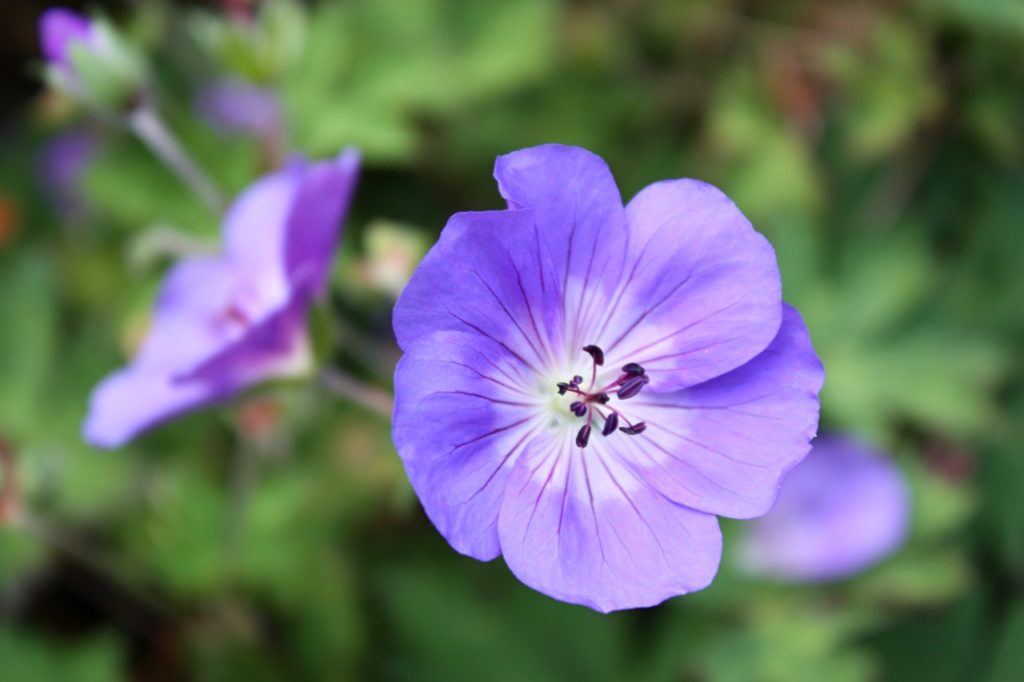
- COMMON NAME(S): Himalayan cranesbill
- HARDINESS RATING: H7
- FOLIAGE: deciduous
- FLOWERING SEASON(S): summer / autumn
- SUNLIGHT: full sun / part shade
Geraniums are prized for their incredibly long blooming seasons, producing a profusion of blooms from late spring through to mid-autumn.
Although the Himalayan cranesbill might not bloom for so long, it will still brighten up your borders for a good few months and is an incredibly easy geranium variety to grow and care for.
22) Agastache foeniculum

- COMMON NAME(S): anise hyssop
- HARDINESS RATING: H3
- FOLIAGE: deciduous
- FLOWERING SEASON(S): summer / autumn
- SUNLIGHT: full sun
Hyssops are deciduous herbaceous perennials and most varieties are of upright, clump-forming habit, but some are bushy.
The vast majority of varieties are 0.5-1m in height.
Many varieties’ foliage, of a soothing, light, sea-green shade, exudes a bracing anise scent.
This particular cultivar displays small tubular flowers densely packed on spikes that are in a stunning lilac hue.
23) Pericallis × hybrida

- COMMON NAME(S): cineraria
- HARDINESS RATING: H3
- FOLIAGE: deciduous
- FLOWERING SEASON(S): summer
- SUNLIGHT: full shade / part shade
Pericallis × hybridas are treated as annuals in open ground but can also be grown as perennial houseplants.
Even though these plants are not hardy enough to be considered outdoor perennials, they are included on this list for their compelling bright, neon-purple blooms.
Cineraria varieties bear wide-open flowers that resemble daisies.
Most varieties are clump-forming evergreens, clocking in at under 50cm, and they display their electric blooms for most of the summer.
24) Lupinus albifrons

- COMMON NAME(S): silver lupine
- HARDINESS RATING: H7
- FOLIAGE: evergreen
- FLOWERING SEASON(S): spring / summer
- SUNLIGHT: full sun
Lupins are predominantly herbaceous deciduous perennials and their flowers boast colours that include numerous shades of purple that are often bicoloured.
Its leaves are palmate with radiating leaflets, and the amusing charm of this star-like foliage is doubled when these plants are grown in pots, as they often are.
From the midst of those leafy stars rise spikes holding aloft brilliantly coloured spires, densely packed with small flowers for the better part of summer.
25) Lupinus ‘Purple Emperor’

- COMMON NAME(S): lupin ‘purple emperor’
- HARDINESS RATING: H5
- FOLIAGE: deciduous
- FLOWERING SEASON(S): summer
- SUNLIGHT: full sun / part shade
This lupin variety has bicoloured flowers that are two variations of purple, adding even more purple into your beds with just a single plant!
This variety will look great in a cottage garden or in your perennial beds and borders when grown alongside other colourful plants.
26) Iris germanica

- COMMON NAME(S): bearded iris
- HARDINESS RATING: H6
- FOLIAGE: evergreen
- FLOWERING SEASON(S): spring
- SUNLIGHT: full sun
Irises are super-hardy bulbous or rhizomatous perennials that come in a wide range of heights, have attractive lily-like foliage and, of course, produce bilaterally symmetric flowers that have contrasting beards (if you opt for the bearded variety!).
This lovely hardy flower works well in most gardens and will provide your spring beds with an abundance of colourful blooms.
27) Iris sibirica

- COMMON NAME(S): Siberian iris
- HARDINESS RATING: H7
- FOLIAGE: deciduous
- FLOWERING SEASON(S): summer
- SUNLIGHT: full sun / part shade
The Siberian iris is another wonderful choice for most gardens in the UK and is actually less fussy than its bearded counterpart.
This deciduous perennial can be grown in all soil types and will also work quite well as ground cover or as a shelter for any wildlife, thanks to the plethora of grassy leaves it produces.
28) Iris ‘Purple Magic’
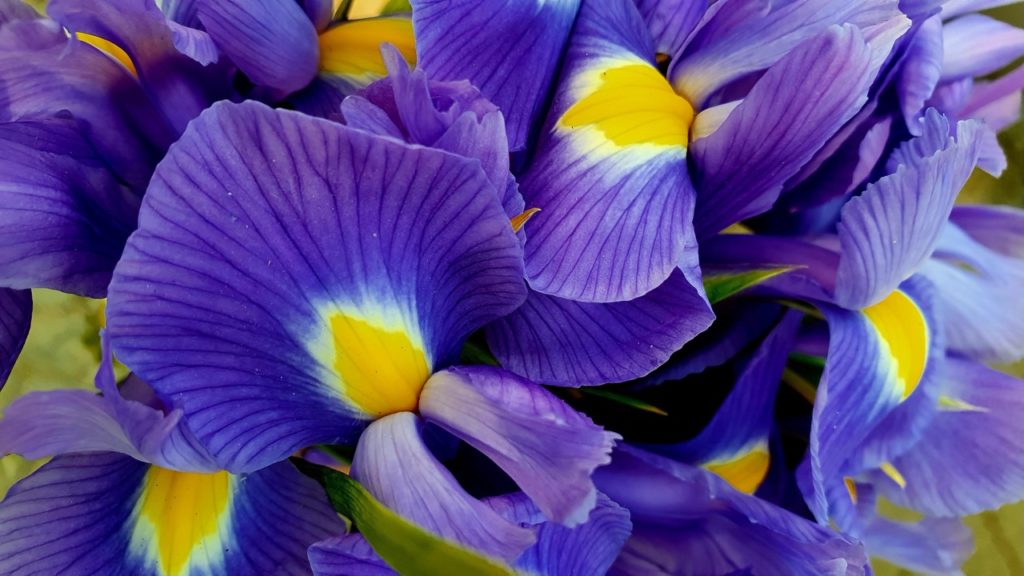
- COMMON NAME(S): iris ‘purple magic’
- HARDINESS RATING: H6
- FOLIAGE: semi-evergreen
- FLOWERING SEASON(S): spring / summer / autumn
- SUNLIGHT: full sun
Most Irises are deciduous perennials while some are evergreens, but this specific cultivar is semi-evergreen.
‘Purple magic’ is the last iris on this list, as it is well worth a mention, producing flowers that last from spring right through to autumn!
If you plant this perennial in a spot in full sun, you are bound to reap the brilliant purple rewards that this plant can provide!
29) Buddleja davidii

- COMMON NAME(S): butterfly bush
- HARDINESS RATING: H6
- FOLIAGE: deciduous
- FLOWERING SEASON(S): summer / autumn
- SUNLIGHT: full sun / part shade
Named after their ability to draw in butterflies and other pollinators in abundance, the butterfly bush is an attractive perennial that can grow up to a towering 4m in height with a spread twice as wide!
They have attractive arcing, swaying, foliage branches that bear a profusion of tiny flowers in various shades of purple.
The prime flowering season is early summer to mid-autumn.
30) Clerodendrum myricoides ‘Ugandense’

- COMMON NAME(S): butterfly bush ‘Ugandense’
- HARDINESS RATING: H1B
- FOLIAGE: evergreen
- FLOWERING SEASON(S): summer / autumn
- SUNLIGHT: full sun / part shade
This evergreen can be difficult to grow in the UK due to its large size and frost-tender hardiness rating.
Too tender to grow outside year-round, but potentially too large to be a houseplant, this stunning purple-flowering perennial is definitely a risk – but I would say it’s worth it!
The very special charm of Clerodendrum myricoides ‘Ugandense’ is that its flowers are shaped like butterflies!
31) Clematis viticella
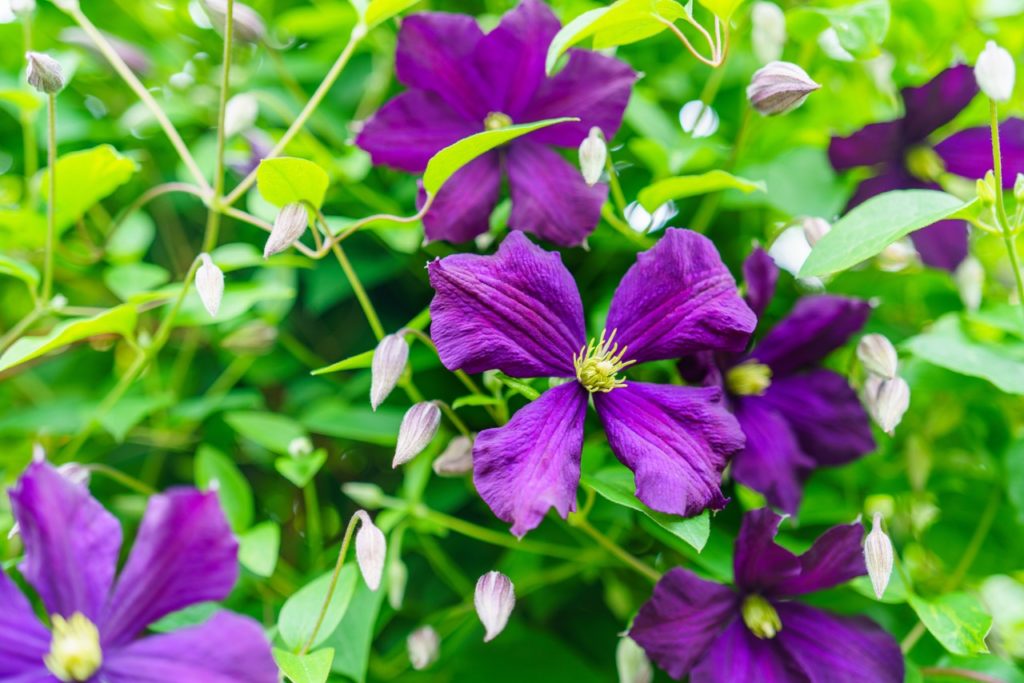
- COMMON NAME(S): Italian leather flowers / Italian clematis
- HARDINESS RATING: H5
- FOLIAGE: deciduous
- FLOWERING SEASON(S): summer / autumn
- SUNLIGHT: full sun / part shade
Although many clematis plants are climbers, there are some perennials that bear purple flowers, including the Italian clematis.
This purple variety is of a rich purple and can grow up to 4m in height with only a 1.5m spread.
Grow this plant against a wall or trellis to get the best results for your garden displays.
32) Dianthus caryophyllus

- COMMON NAME(S): border carnation
- HARDINESS RATING: H4
- FOLIAGE: evergreen
- FLOWERING SEASON(S): summer
- SUNLIGHT: full sun
You wouldn’t think of dianthus, usually associated with white, pinks and reds, as perennials that bear purple flowers, but many varieties do, and they are special and spectacular.
Most of these are herbaceous evergreen perennials that grow between 20-90cm in height.
The flowers are spectacular as they burst open with pinky-purple colour that is often different shades around the edges.
33) Rhododendron ponticum
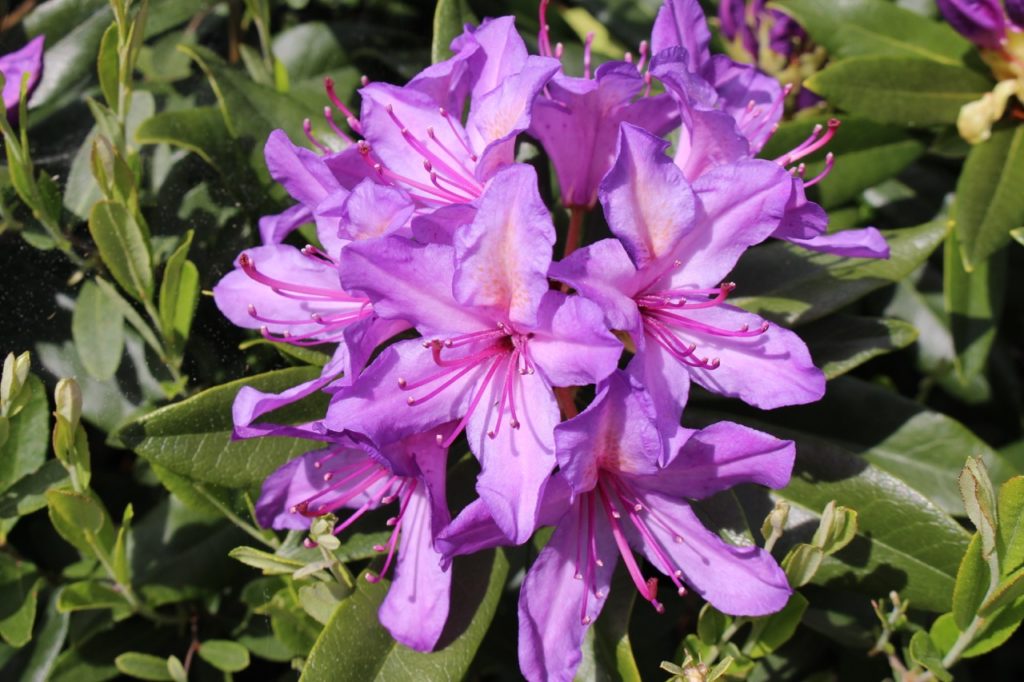
- COMMON NAME(S): pontica rhododendron
- HARDINESS RATING: H6
- FOLIAGE: evergreen
- FLOWERING SEASON(S): spring
- SUNLIGHT: full shade / part shade / full sun
Although not all that common, there are some stunning purple R. ponticum varieties lend themselves to garden cultivation here in the UK.
This larger rhododendron variety grows up to 4m in height and spread and can be a great choice for a hedge or for the back of a garden border.
Their purple star-shaped blooms are bound to signal the start of spring when they emerge as soon as the weather starts to warm up again after winter.
34) Rhododendron kaempferi
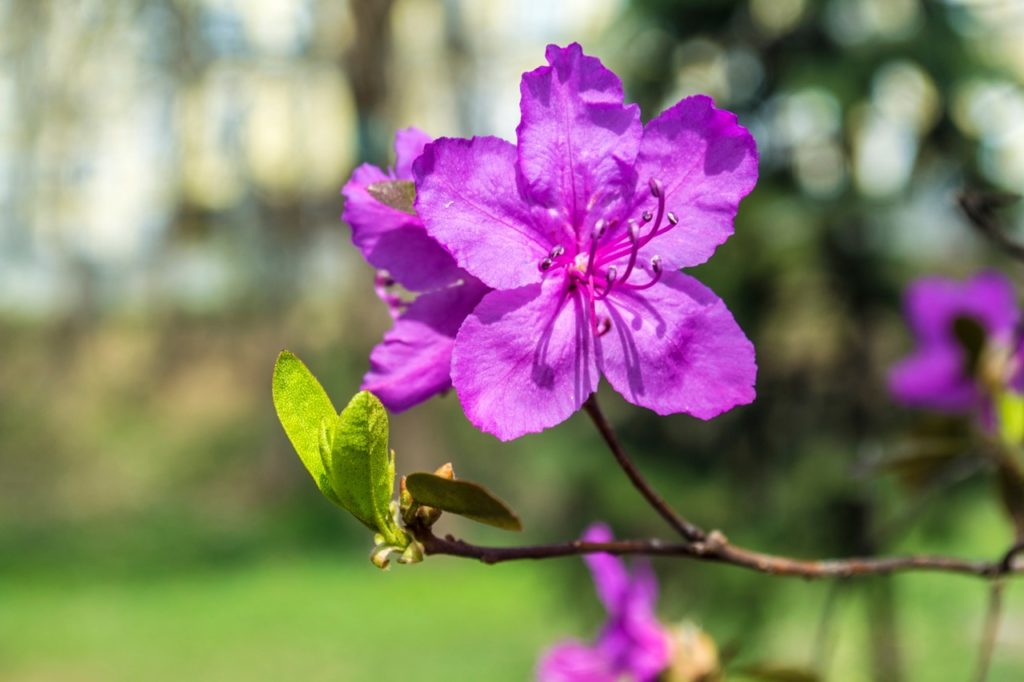
- COMMON NAME(S): Kaempferi azalea / torch azalea
- HARDINESS RATING: H7
- FOLIAGE: evergreen
- FLOWERING SEASON(S): spring
- SUNLIGHT: full sun / part shade
Torch azalea is a touch smaller than the previous rhododendron, but it can still reach an impressive 2.5m in height.
The shades of purple that this azalea comes in are typically pinkish-purple to magenta-purple.
35) Oxalis triangularis

- COMMON NAME(S): purpleleaf false shamrock
- HARDINESS RATING: H3
- FOLIAGE: deciduous
- FLOWERING SEASON(S): summer
- SUNLIGHT: part shade
With purple foliage instead of purple flowers, the purple shamrock is a deciduous perennial of clump-forming habit.
This plant produces tiny funnel-shaped flowers, which are usually pale pink.
However, it is the lobed clover-like leaves that are purple and provide stunning visual interest.
36) Trifolium pratense

- COMMON NAME(S): red clover
- HARDINESS RATING: H7
- FOLIAGE: deciduous
- FLOWERING SEASON(S): spring / summer
- SUNLIGHT: full sun
The first of two clovers on this list, red clovers produce flowers in the spring and summer that are somewhat spherical or ovoid.
These stunning purple blooms dance on tall stems up to 50cm in height with double the spread and will make a great addition to perennial borders or a cottage garden display.
37) Trifolium rubens

- COMMON NAME(S): ruddy clover
- HARDINESS RATING: H7
- FOLIAGE: semi-evergreen
- FLOWERING SEASON(S): spring / summer
- SUNLIGHT: full sun
Ruddy Clovers are usually semi-evergreens with clump-forming or bushy habits.
They produce dense cylindrical clusters of tiny pinky-purple flowers on green stems that grow up to 1m in height, taller than those of the red clover.
38) Hydrangea macrophylla

- COMMON NAME(S): hortensia
- HARDINESS RATING: H5
- FOLIAGE: deciduous
- FLOWERING SEASON(S): summer
- SUNLIGHT: full sun / part shade
Hydrangea macrophylla, renowned for its ability to change colours, gives you the liberty to take any pink or blue variety and purple-shift it by changing your soil pH!
However, you can also purchase many purple varieties that will save you the trouble of altering your growing medium too much.
“When buying a Hydrangea macrophylla, you should be aware that regardless of the flower colour you buy, it will shift over time to match the soil conditions you have unless you alter the soil pH with amendments,” explains Dan.
“Alkaline soils (pH 6.5-7.5) produce pink flowers, acid soils (pH 4.5 – 5.5) will produce blue flowers, and neutral to acidic soils (pH 5.5 – 6.5) are best for maintaining purple flower colour.”
This flower’s floral forms include fluffy-looking, rounded mop heads and flattish lace caps that are produced during summer into autumn.
References
- 1Invasive to Avoid: Big Periwinkle. (n.d.). Wildlife. Retrieved March 23, 2023, from https://wildlife.ca.gov/Conservation/Plants/Dont-Plant-Me/Big-Periwinkle


